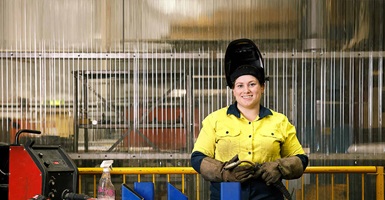You may have an image in your mind of what a typical IT professional looks like. Chances are, they are male.
Though the tech industry has traditionally been dominated by men, it’s fast becoming more accessible to women.
Bavita Gupta, Information Technology education manager at Chisholm, says there are some interesting industry shifts behind this trend.
With 20 years of IT industry experience herself, Bavita says it’s “a myth” that women can’t do well in tech jobs. She stresses “there’s no limit to what you can achieve” as a woman in the industry.
While there’s still a way to go before the tech industry reaches gender parity, more women are taking on thriving careers in tech. Here’s what’s driving them.
Huge demand for tech professionals
In Australia and around the world, there’s huge demand for information technology skills.
Bavita says, due to our increased reliance on technology throughout the pandemic, IT professionals are now more highly sought after than ever.
With the right qualifications, for example, you could find a role as a:
- Programmer or developer
- Cybersecurity professional
- Network or system administrator
Find out more about what each of these jobs involve.
High-paying, high-growth jobs
Thanks to the high demand and the skill involved, technology jobs often fetch high salaries.
Bavita estimates the salary range for qualified IT professionals in Australia “starts at 70k and goes to 140, 150, 160k – and even higher”.
Database and system administrators, for example, can expect to take home an average pay-packet of $2342 a week, according to the Australian government’s Labour Market Insights. ICT managers can expect about $3000 a week.
A particular high-growth area you may like to keep in mind is cybersecurity. Aust Cyber projects that nearly 17,000 more cybersecurity workers will be needed in Australia by 2026, with salaries that reflect the demand.
Bavita says if you’re just starting out in the IT industry, you’ll likely first take on an entry-level role such as junior cybersecurity analyst or level one networking support – but you’ll have plenty of opportunity for career progression.
Flexibility is more possible
One big reason more women are entering the industry is the increased emphasis on workplace flexibility.
It’s now commonplace – especially in larger companies – for tech workers to negotiate flexible working arrangements.
You may be able to arrange a shorter working week, your own start or finish times, or work be able to work from home or remotely.
Bavita says this culture shift is helping break down a barrier for women with caring responsibilities.
“More and more organisations are now providing flexibility as people have realised how important it is to balance their family lives and work lives,” she says.
“This is a great opportunity for women to get into the industry given they can often be the ones looking after kids and their household.
“These can be demanding jobs, but if there is flexibility, women can adjust when they work and don’t necessarily have to be nine to five.”
More support for Women in STEM
Many organisations recognise the importance of encouraging women in tech roles, and dedicated programs or associations can provide a support network as you grow your career.
For example, Bavita says Chisholm recently launched its Women in Business, Finance and Technology program to give more women a leg up into industries in which they’ve been typically underrepresented, such as technology.
The program is designed to complement your technology course at Chisholm, and includes industry placement and mentorship, tailored career counselling, and support for your first three months of a new job.
Backed by funding from the National Careers Institute, the program is available free of charge to women who live in Melbourne’s greater south-east.
How can you start your career in IT?
If you’re just starting out, Bavita suggests taking a course like Certificate III in Information Technology, which introduces a range of tech topics, so you can see what resonates with you.
“This course will give you a taste of a little bit of everything – from operating systems to web fundamentals, help desk programming fundamentals, networking to cloud technologies,” she says.
From there, you may like to continue your studies to specialise in a particular area, such as programming or cybersecurity.
Bavita says gaining practical and industry experience is a great way to develop your skills and CV, which can help you stand out when looking for a job.
For example, students can choose to complete an IT traineeship to gain on-the-job training from an employer.
Participants in Chisholm’s Women in Business, Tech and Finance program undertake an industry placement with audio-visual company, EQUANS.


